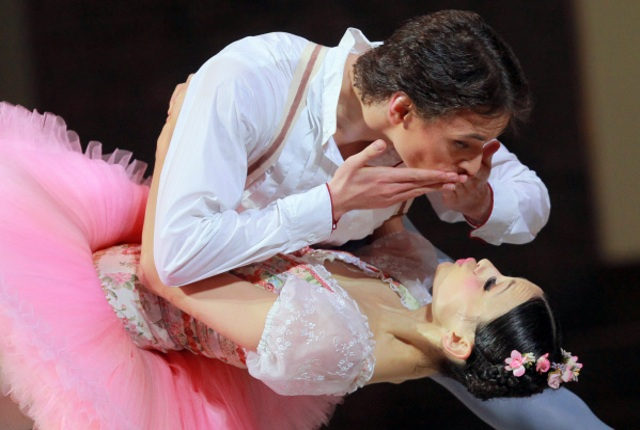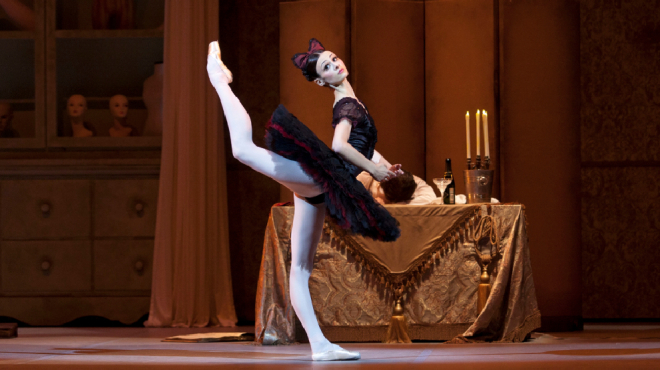When a person is happy in his work, he does his best. So best ignore what Sergei Polunin says on the page of a newspaper and look at what he does on stage. Now there’s a happy boy. Polunin is the one reason to see the Stanislavsky Ballet at the Coliseum on this short visit, though it's always a pleasure to hear Delibes’s divine score to which Roland Petit created a short, pert, thin and very French version of Coppélia, chockful with kisses.
A fairground organ wheezes out Swanilda’s lilting waltz, and the curtains part on a pleasing pale grey marble courtyard. It is a weird story, under its pink prettiness - seriously, why is Franz two-timing his girlfriend with a doll? Who is the dollmaker? Why does he make love to his doll? Once he’s mined Franz of his soul to give to the doll, will Franz ever wake up? And what does it matter so long as Sergei Polunin is happily dancing?
 His leaps are as blithe as a shaft of sunshine, and come from nowhere, weightless. His turns are not quite as good, and his partnering is clumsy. But Polunin like this (as opposed to the disengaged creature he was at Alina Cojocaru's gala) is a relaxed, mesmerising stage creature, an entirely natural actor in his metier, who makes you love him despite everything. And that haunting, aquiline face with its old shadows on a young face, continues to be troubling. You do wonder what kind of hellcat Coppélia Dr Coppelius would have made with Polunin’s moody essences, rather than simpleton Franz's.
His leaps are as blithe as a shaft of sunshine, and come from nowhere, weightless. His turns are not quite as good, and his partnering is clumsy. But Polunin like this (as opposed to the disengaged creature he was at Alina Cojocaru's gala) is a relaxed, mesmerising stage creature, an entirely natural actor in his metier, who makes you love him despite everything. And that haunting, aquiline face with its old shadows on a young face, continues to be troubling. You do wonder what kind of hellcat Coppélia Dr Coppelius would have made with Polunin’s moody essences, rather than simpleton Franz's.
There’s a super photo in the programme book of young Roland Petit smirking diabolically, like a man who has at least two subplots going on in his head. One of the greatest character dancers ever, he was Dr Coppelius when he created the ballet in 1975, and no doubt in his performance he could transform the weirdness into a secret allegory about the choreographer and the girl character he’s inventing. No doubt it was plangent, funny, touching, with a hint of Dracula. The Stanislavsky’s Dr Coppelius, Anton Domashev, is as greasily debonair as a tango tutor, smoothing his brilliantined black hair as he sets dinner for his doll and whisks her into a close embrace - he avoids the perve connotations, just, by playing it for laughs.
The girls’ bouncy rose-pink tutus were made with wriggling in mind, and Petit has lots of wriggling in mind
Which is the way this production goes. It has no substance, it feels perfunctory. There are moues and pouts and naughty faces everywhere (it’s very French). The girls’ bouncy rose-pink tutus were made with wriggling in mind, and Petit has lots of wriggling in mind. They blow fusillades of kisses at the soldiers, who dive to their knees and hold lips to attention for a quick French smacker.
It may seem hard to believe, but Swanilda, the dumb girl who impersonates a doll, is a wonderful ballerina role, full of comedic byplay, sexy flirting and (in most cases) quick-footed bravura to match the irresistible sparkle of the music. She hasn’t the knowing virtuosity of Kitri in Don Quixote - Swanilda is probably about 16, adorable and eternally hopeful that Franz will come home for tea.
 Despite the simplicity of the dancing challenge, there should be plenty of space for a good actress to conquer our hearts with her wit and allure. The Stanislavsky ballerina Kristina Shapran is cute, with black hair, a doll-like face and exceptionally long legs, a very young filly. She’s slightly too tall for Polunin, which adds to her charming impression, but dewy as she is, she still has to acquire the virtuosic flair a great Swanilda needs, and I wasn't sure if the skimpiness of the steps was down to Petit or her not quite making them.
Despite the simplicity of the dancing challenge, there should be plenty of space for a good actress to conquer our hearts with her wit and allure. The Stanislavsky ballerina Kristina Shapran is cute, with black hair, a doll-like face and exceptionally long legs, a very young filly. She’s slightly too tall for Polunin, which adds to her charming impression, but dewy as she is, she still has to acquire the virtuosic flair a great Swanilda needs, and I wasn't sure if the skimpiness of the steps was down to Petit or her not quite making them.
The choreography is classical-style, fast and tittuping, with lots of Petit-isms (Petiteries?) - kissy-kissy and sauciness, Lindyhop stuck-out bums, shoulder shrugs and mock rage. The corps de ballet are soldiers and town-girls, bunnyhopping in boots, bustles and bonnets, in line-dances studded with kisses and ooh-la-la. Petit looks to have derived their steps from marionettes, hands patting hearts, bodies dropping forward or back as if a string had slackened - it dovetails neatly with the revelation of the doll Coppelia’s inner workings, and with the delightful sound of that cranky little organ in the orchestra.
The English National Ballet Orchestra takes the visiting Stanislavsky conductor Anton Grishanin’s brisk tempi neatly if without the last degree of charm, and the company dance up a storm of cheer, if without the last degree of musical interest. It makes for an undemanding time, not the best Coppélia, not the best of Petit. But it is, surprisingly, among the best of Polunin.
- The Moscow Stanislavsky Ballet perform Coppelia at the London Coliseum till Sunday














Add comment